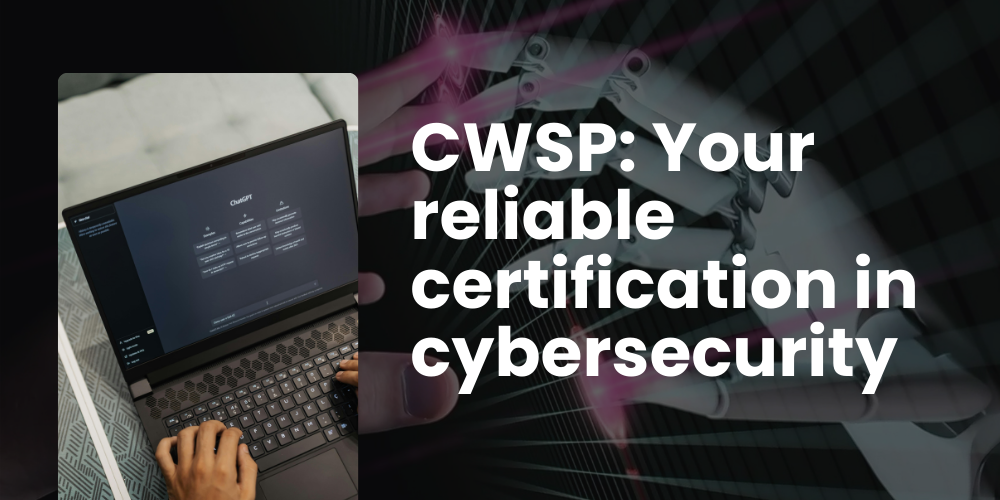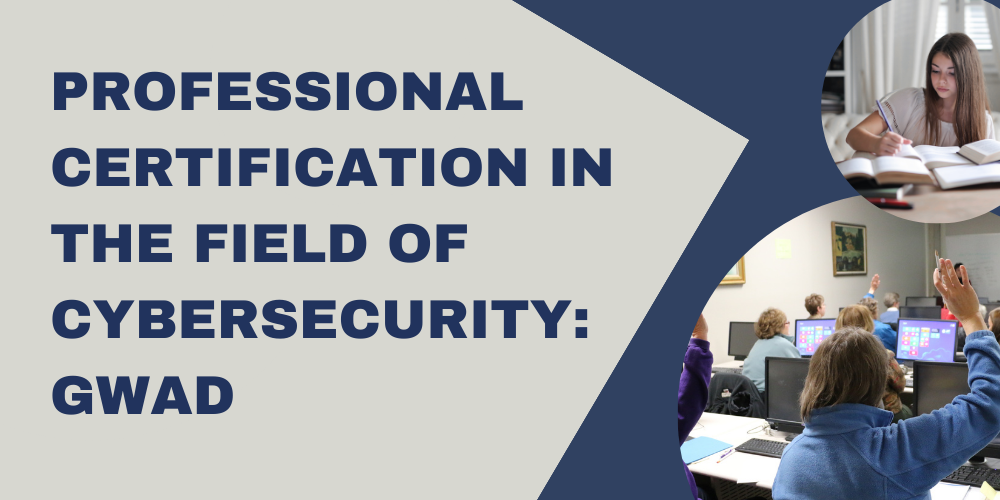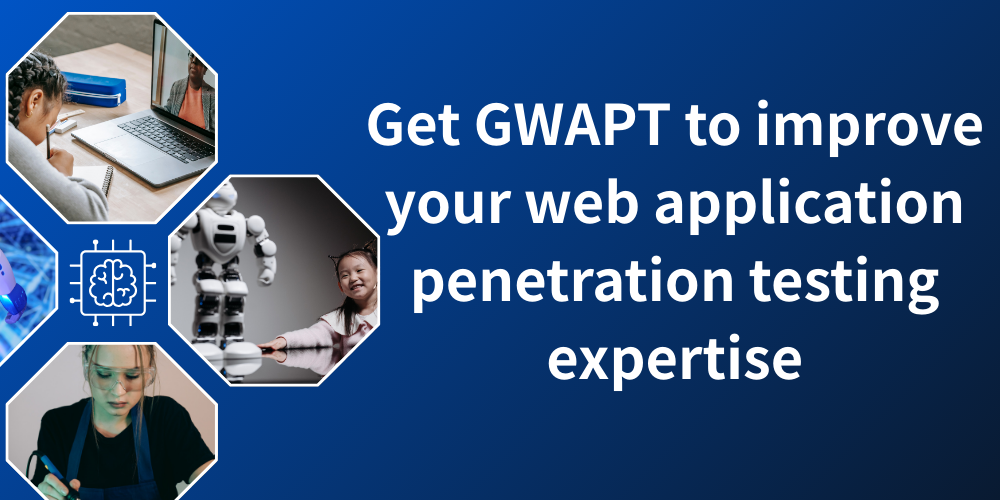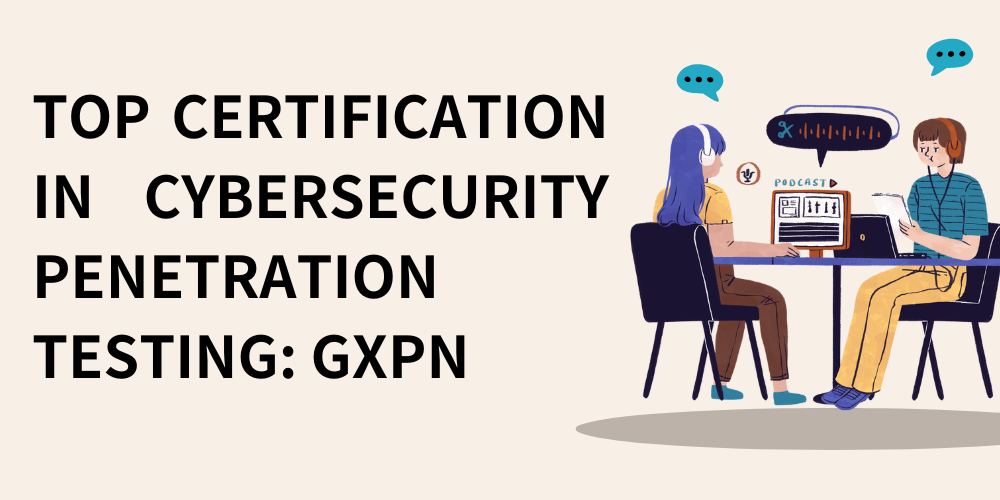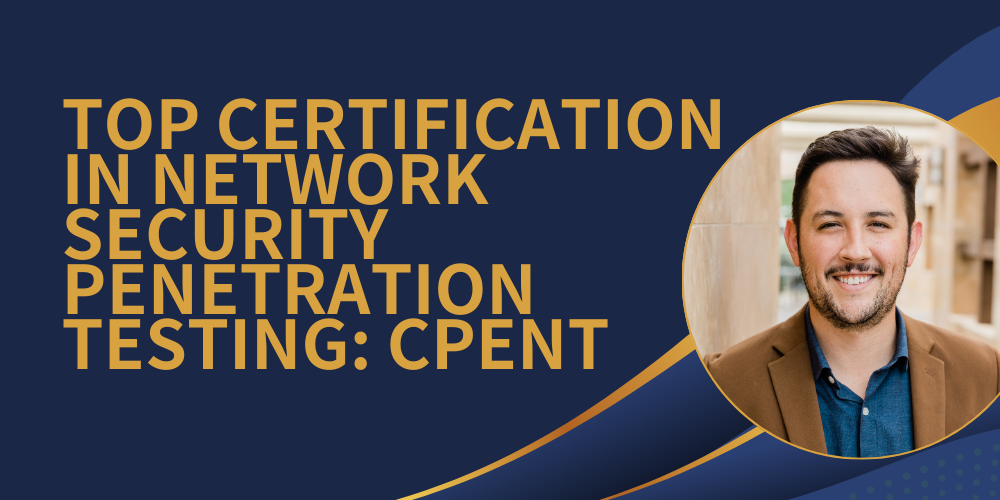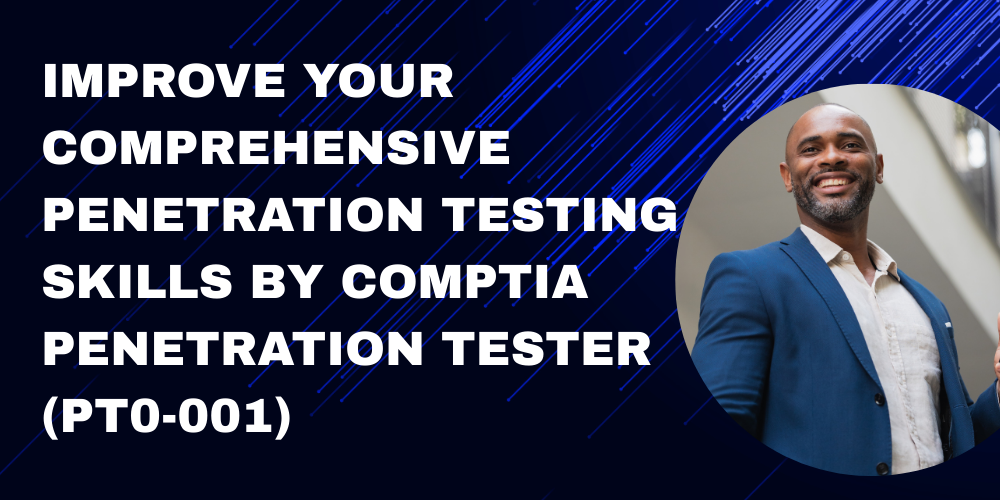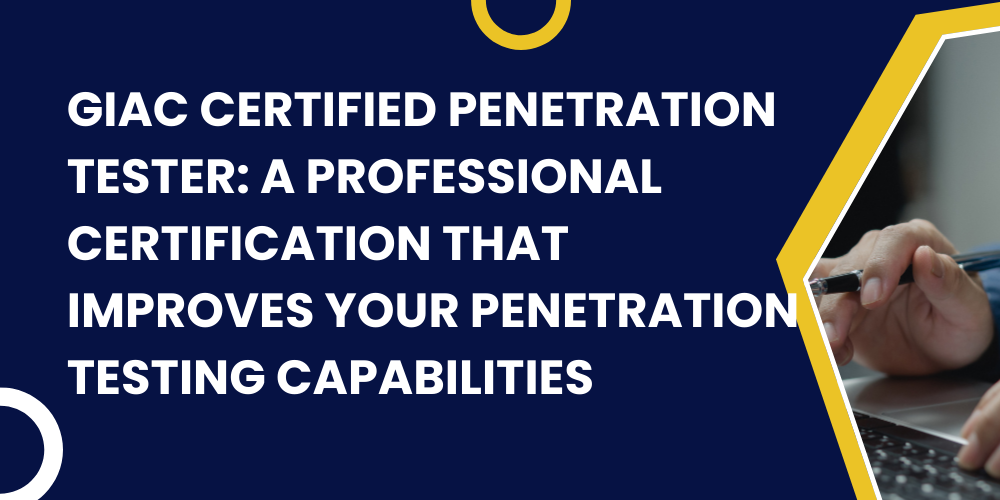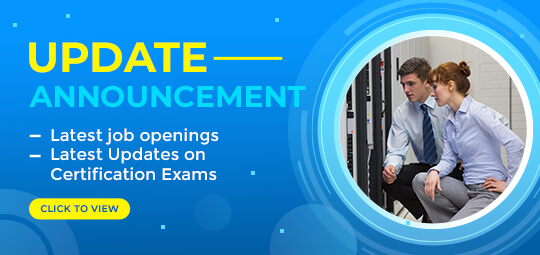TRUSTED BY THE SMARTEST TEAMS IN THE WORLD FOR CERTIFIED CANDIDATES
SPOTO Blogs
Useful learning materials to become certified IT personnel
-
- 542
- SPOTO 2
- 2025-09-16 10:59
-
- 588
- SPOTO 2
- 2025-09-15 13:40
-
- 541
- SPOTO 2
- 2025-09-12 14:08
-
- 957
- SPOTO 2
- 2025-09-11 11:24
-
- 1071
- SPOTO 2
- 2025-09-10 11:10
-
- 537
- SPOTO 2
- 2025-09-09 14:11
-
- 549
- SPOTO 2
- 2025-09-08 11:24
-
- 601
- SPOTO 2
- 2025-09-05 10:26
-
- 599
- SPOTO 2
- 2025-09-04 10:43
TRUSTED BY THE SMARTEST TEAMS IN THE WORLD FOR CERTIFIED CANDIDATES
SPOTO Blogs
Useful learning materials to become certified IT personnel
-
- 542
- SPOTO 2
- 2025-09-16 10:59
Table of Contents1. Introduction to the Certified Web Security Professional certification2. The Competitive Edge of a CWSP Certification3. Core Components of the CWSP Certification4. What are the requirements to be a Certified Web Security Professional?5. Comparable Certifications to Certified Web Security Professional certification In this article, CWSP is a certification dedicated to improving your professional ability in web security assurance and cultivating relevant talents for enterprises. 1. Introduction to the Certified Web Security Professional certification EC-Council Certified Web Security Professional (CWSP) is a professional certification offered by EC-Council specifically focused on web security. It verifies your professional knowledge and practical skills in securing web applications and related network environments. It is highly influential and recognized within the cybersecurity industry. With the rapid development of the internet, web applications have become an integral part of our lives, work, and business operations. However, the security risks they face are also increasing in number and complexity. The core of the EC-Council Certified Web Security Professional (CWSP) is to cultivate and certify professionals who possess comprehensive knowledge and skills in web security, building a strong security defense for web applications, effectively defending against various network attacks, ensuring data security, and ensuring the normal operation of web applications. These professionals are like the "security guardians" of the Web world. They can delve into every aspect of Web application development, deployment, operation and maintenance, and use professional detection, protection and response methods to discover and resolve common and emerging security threats such as SQL injection, cross-site scripting attacks, malicious file uploads, phishing, etc., helping enterprises protect their core business data, maintain brand reputation and ensure a good user experience. 2. The Competitive Edge of a CWSP Certification The EC-Council Certified Web Security Professional (CWSP) certification is highly respected and authoritative in the cybersecurity field, particularly in web security. Obtaining this certification signifies that you have undergone rigorous professional assessment and possess web security skills that meet high industry standards. This will enhance your competitiveness in job applications for highly specialized roles in web security, development, operations, and maintenance, making you more attractive to companies. The CWSP certification focuses on the key niche of web security and is a valuable asset in transitioning from entry-level and mid-level cybersecurity positions to senior web security specialists, security architects, and other high-level positions. Earning the CWSP certification broadens your career path and often significantly increases your salary. The process of preparing for and obtaining the certification encourages you to systematically and comprehensively acquire comprehensive web security knowledge and skills. This will enable you to better address increasingly complex web security threats and diverse security scenarios, playing a key role in ensuring the secure and stable operation of enterprise web applications. Cybersecurity technology is rapidly evolving, and web security methods and tools are constantly changing. The CWSP certification's continuing education requirements compel you to stay current with industry trends, acquire new knowledge and skills, and stay abreast of industry developments. This ensures your professional expertise remains relevant to the ever-changing cybersecurity landscape, including keeping up with cutting-edge content like new security technologies and the latest threat intelligence. 3. Core Components of the CWSP Certification The CWSP certification system builds a comprehensive knowledge system for web security,it's ideal for those pursuing careers in web security development, penetration testing, security operations, and management. Through this course, you'll gain a deep understanding of common web architectures and their security risks, master the security features of mainstream development languages and frameworks, develop a comprehensive understanding of security threats, and master a combination of automated and manual vulnerability discovery techniques. This allows you to comprehensively identify various risks, including business logic vulnerabilities, and systematically analyze and categorize vulnerability causes. Secondly, you'll master multi-layered defenses such as input validation, identity authentication, access control, encryption, and WAF configuration to enhance your application's overall attack resistance. Finally, you will understand and use black-box, white-box, gray-box and other testing methods, conduct assessments in combination with international standards such as OWASP, and write professional security reports. You will be able to organize effective security training, master the security incident handling process, achieve rapid response, recovery and review, and comprehensively improve the team's security capabilities. 4. What are the requirements to be a Certified Web Security Professional? (1) Qualification prerequisites: EC-Council officially recommends that you have a basic understanding of network security, including familiarity with common network protocols, operating systems, and basic network security concepts. This foundational knowledge will help you better understand and master the web security expertise and skills required for the CWSP. While there is no strict work experience requirement, previous experience in web application development, security testing, operations, and other related fields will be beneficial for exam preparation. (2) Training and examinations: The CWSP exam typically lasts approximately four hours and includes a variety of question types, including multiple-choice questions and practical exercises. These questions comprehensively assess candidates' knowledge of various aspects of web security and their ability to apply them in practical applications. According to the official standards set by EC-Council, candidates must meet certain assessment requirements to pass the exam. These requirements typically require candidates to demonstrate professional competence in security vulnerability detection, application of protection technologies, security testing, and emergency response, accurately completing tasks, and clearly explaining the rationale and rationale behind each operation, demonstrating the ability to independently conduct web security work. The exam fee is approximately US$1,500, with slight variations depending on the region. (3) Qualification maintenance: The CWSP certificate is valid for 3 years and to maintain the validity of the certificate, you need to participate in continuing education activities officially recognized by EC-Council during the validity period. 5. Comparable Certifications to Certified Web Security Professional certification GIAC Certified Web Application Penetration Tester (GWAPT) Certified Web Application Security Professional (CWASP) GIAC Web Application Defender (GWAD) CompTIA Security+ -
- 588
- SPOTO 2
- 2025-09-15 13:40
Table of Contents1. Introduction to the Certified Web Application Security Professional certification2. The Competitive Edge of a CWASP Certification3. Core Components of the CWASP Certification4. What are the requirements to be a Certified Web Application Security Professional?5. Comparable Certifications to Certified Web Application Security Professional certification In this article, CWASP is a highly valuable professional certification in the field of network security, dedicated to enhancing your expertise in web application security. 1. Introduction to the Certified Web Application Security Professional certification Certified Web Application Security Professional (CWASP), also known as Certified Web Application Security Expert, is a certification that focuses on the field of web application security and aims to verify that you have professional knowledge and practical skills in ensuring web application security. It plays an important role in the network security industry. In today's digital age, web applications are ubiquitous, from e-commerce platforms, social media to enterprise office systems, carrying massive amounts of business and user data, while also facing various complex and severe security threats. The core of Certified Web Application Security Professional (CWASP) is to cultivate and certify professionals who have a deep understanding of the principles, mechanisms, and potential risks of web application security, are proficient in various security protection technologies and strategies, and can comprehensively ensure the security of web applications. These professionals are like the "security guards" of web applications. They can intervene in the entire lifecycle stages of web application development, deployment, and operation, using their professional knowledge and skills to discover and fix security vulnerabilities, resist external attacks, ensure data security, and guarantee application availability, laying a solid security defense for the normal operation of online business for enterprises. 2. The Competitive Edge of a CWASP Certification Obtaining CWASP certification means that you have undergone rigorous professional assessments and mastered web application security skills that meet high industry standards. When applying for positions involving web application security protection, development, operation and maintenance, you will have strong competitiveness and be more likely to win the favor of enterprises. CWASP certification focuses on the key subfield of web application security and is an important support for you to move from junior and intermediate network security positions to high-level positions such as senior web application security expert and security architect. By obtaining CWASP certification, you can broaden your career development path and often see a significant increase in salary and benefits. The process of preparing for exams and obtaining certifications enables you to systematically and comprehensively learn various knowledge and skills related to web application security, from security vulnerability mining and protection technology application to security testing, emergency response, and other aspects for in-depth learning and practical exercise. This enables you to better respond to increasingly complex web application security threats and diverse security scenarios, playing a key role in ensuring the safe and stable operation of enterprise web applications. The technology in the field of network security is updating rapidly, and the methods and tools for web application security are also constantly changing. The continuing education requirements of CWASP certification force you to continuously pay attention to industry trends, learn new knowledge and skills, keep pace with industry development, and ensure that your professional abilities always adapt to the constantly changing new situation in the field of network security, such as keeping up with new security protection technologies, the latest security threat intelligence, and other cutting-edge content. 3. Core Components of the CWASP Certification The CWASP certification system has built a complete knowledge system in the field of web application security, covering the core competencies of the entire process from security basics, vulnerability mining to protection technology, security development, and emergency response. It is suitable for those who are committed to web security development, security testing, security operation and maintenance, and security management to prepare for the exam. Through learning, you will gain a deep understanding of common architectures, operating mechanisms, and threat models, establish a comprehensive security awareness, and master the combination of automated and manual vulnerability detection techniques, analyze the causes of vulnerabilities, and systematically classify them. Secondly, you will be proficient in input verification, identity authentication, encryption technology, and security configuration, implementing multi-level defense, integrating security into the entire development process, standardizing coding and operation management, building sustained security capabilities, and learning to use black box, white box, and other testing methods to evaluate and write professional reports based on international standards. Finally, you can receive targeted security training, master the process of handling security incidents, and enhance the overall response capability of the team. 4. What are the requirements to be a Certified Web Application Security Professional? (1) Qualification prerequisites: The certification examination agency recommends that you have a certain basic knowledge of network security, be familiar with common network protocols, operating systems, and basic network security concepts. These basic knowledge will help you better understand and master the professional knowledge and skills of web application security involved in CWASP. Although there is no strict work experience requirement, having experience in web application development, security testing, operations, and other related work will be more beneficial for you to prepare for the exam, as practical work experience can help you better understand the application of web application security in real scenarios and the various situations it faces, which is helpful for dealing with the practical operation part of the exam. (2) Training and examinations: The CWASP exam usually lasts for about 4 hours, with various types of questions including multiple-choice questions, practical operation questions, etc. It comprehensively tests your mastery of various aspects of web application security knowledge and practical application abilities. Practical exercises will simulate some real web application security scenarios, requiring you to apply the knowledge and skills you have learned to solve problems that are more closely related to actual work situations. According to the standards set by relevant authorities, you need to meet certain assessment requirements to pass the exam. Usually, you are required to demonstrate professional abilities in security vulnerability mining, protection technology application, security testing, emergency response, etc., accurately complete corresponding tasks, and clearly explain the principles and basis of various operations, demonstrating the ability to independently carry out web application security protection work. The exam fee is roughly around $1500, and there may be slight differences in fees in different regions. (3) Qualification maintenance: The CWASP certificate is valid for 3 years. In order to maintain the validity of the certificate, you need to accumulate certain credits by participating in officially recognized continuing education activities during the validity period. 5. Comparable Certifications to Certified Web Application Security Professional certification GIAC Certified Web Application Penetration Tester (GWAPT) GIAC Web Application Defender (GWAD) Offensive Security Certified Professional (OSCP) Certified Ethical Hacker (CEH) -
- 541
- SPOTO 2
- 2025-09-12 14:08
Table of Contents1. Introduction to the GIAC Web Application Defender certification2. The Competitive Edge of a GWAD Certification3. Core Components of the GWAD Certification4. What are the requirements to be a GIAC Web Application Defender?5. Comparable Certifications to GIAC Web Application Defender certification GWAD is a professional certification that improves your web application security defense capabilities and cultivates web application security defense talents for firms. 1. Introduction to the GIAC Web Application Defender certification GIAC Web Application Defender (GWAD) is a professional certification offered by Global Information Assurance Certification (GIAC) that focuses on web application security and defense. It verifies practitioners' expertise in protecting web applications from various cyberattacks and building secure web application environments. In today's rapidly expanding internet landscape, web applications have become the core platform for many businesses to conduct business and interact with customers. However, they also face an increasing number of increasingly sophisticated cyberattack threats. The core of the GIAC Web Application Defender (GWAD) certification is to cultivate and certify professionals who can build a robust defense system for web applications and effectively defend against various security threats. These professionals act as the "guardians" of web application security. They are familiar with the architectural features of web applications, common attack methods, and corresponding defense strategies. They can use their professional knowledge and skills to intervene in web applications from the development stage, throughout the entire process of deployment, operation, and maintenance. By configuring security protection mechanisms, formulating security policies, and monitoring abnormal behaviors, they can ensure the confidentiality, integrity, and availability of Web applications, prevent malicious attackers from exploiting vulnerabilities to carry out malicious activities such as data theft, service interruption, and tampering with page content, and ensure that the company's Web applications can safely and stably support business operations. 2. The Competitive Edge of a GWAD Certification As a globally renowned cybersecurity certification body, GIAC's Web Application Defender (GWAD) certification is highly authoritative and recognized in the cybersecurity field, particularly in web application security defense. Obtaining this certification demonstrates that you have undergone rigorous professional assessment and possess web application security defense skills that meet high industry standards. This makes you highly competitive when applying for highly specialized positions such as web application security protection and network security operations, making you more attractive to employers. GWAD certification focuses on the key niche of web application security defense and is a crucial step in your journey from entry-level and mid-level cybersecurity positions to senior web application security specialists, security architects, and other high-level positions. By earning GWAD certification, you can broaden your career path and often significantly increase your salary. The process of preparing for and obtaining the certification compels you to systematically and comprehensively acquire comprehensive knowledge and skills in web application security defense. This includes in-depth study and practical training across all aspects of web application security, from security policy formulation and application of protection technologies to vulnerability management and security monitoring. This empowers you to better address increasingly complex web application security threats and diverse security defense scenarios, playing a key role in ensuring the secure and stable operation of enterprise web applications. Technology in the cybersecurity field is rapidly evolving, and web application security defense methods and tools are also constantly changing. The continuing education requirements of the GWAD certification compel you to continuously monitor industry trends, acquire new knowledge and skills, and stay abreast of industry developments, ensuring your professional capabilities remain relevant to the ever-changing cybersecurity landscape. 3. Core Components of the GWAD Certification The GWAD certification system builds a comprehensive knowledge system for web application security defense, covering core areas from security architecture understanding and strategy formulation to technical implementation, emergency response, and team collaboration. It's ideal for those pursuing careers in web security protection, security operations, security management, and compliance auditing. Through exam preparation, you'll gain a deep understanding of mainstream web application architectures and their vulnerabilities, master common attack types and threat trends, and develop a comprehensive risk awareness. You'll also learn to develop a security policy framework aligned with your business goals and implement domestic and international compliance requirements like GDPR and PCI DSS. Secondly, you'll master key technologies such as WAF configuration, IDS/IPS deployment, encryption, and certificate management to effectively identify and intercept attacks. You'll be able to utilize a combination of automated and manual methods to comprehensively scan and assess vulnerabilities, develop remediation plans, and implement system hardening. Finally, you'll establish real-time monitoring mechanisms, familiarize yourself with security incident handling processes, ensure rapid response, effective containment, and business recovery, conduct targeted security awareness education, and develop the ability to collaborate with development, operations, and business departments to implement security measures. 4. What are the requirements to be a GIAC Web Application Defender? (1) Qualification prerequisites: GIAC officially recommends that you have a basic understanding of network security, including familiarity with common network protocols, operating systems, and basic network security concepts. This foundational knowledge will help you better understand and master the web application security and defense knowledge and skills required for the GWAD exam. This practical work experience will provide you with a more intuitive understanding of the real-world application of web application security and defense and the various situations encountered, helping you prepare for the practical application portion of the exam. (2) Training and examinations: The GWAD exam typically lasts four hours and includes a variety of question types, including multiple-choice questions and practical exercises. The practical exercises simulate real-world web application security and defense scenarios, requiring you to apply your knowledge and skills to solve problems that are more realistic and authentic to real-world situations. According to the official GIAC standards, you must meet certain assessment requirements to pass the exam. These typically require you to demonstrate professional competence in security policy development, application of protection technologies, vulnerability management, and security monitoring. You must accurately complete tasks and clearly explain the rationale and rationale behind each operation, demonstrating your ability to independently conduct web application security and defense work. The GWAD exam fee is approximately US$1,799, with price fluctuations depending on the region. (3) Qualification maintenance: The GWAD certificate is valid for 4 years and in order to maintain the validity of the certificate, you need to accumulate a certain number of credits by participating in GIAC officially recognized continuing education activities during the validity period. 5. Comparable Certifications to GIAC Web Application Defender certification Certified Web Application Security Professional (CWASP) Offensive Security Certified Professional (OSCP) EC-Council Certified Web Security Professional (CWSP) Certified Information Systems Security Professional (CISSP) -
- 957
- SPOTO 2
- 2025-09-11 11:24
Table of Contents1. Introduction to the Certified Web Application Penetration Tester certification2. The Competitive Edge of a GWAPT Certification3. Core Components of the GWAPT Certification4. What are the requirements to be a Certified Web Application Penetration Tester?5. Comparable Certifications to Certified Web Application Penetration Tester certification GWAPT is a certification that improves your web application penetration testing expertise and helps companies screen and train professional web application testing talent. 1. Introduction to the Certified Web Application Penetration Tester certification The GIAC Certified Web Application Penetration Tester (GWAPT) is a professional certification offered by GIAC that focuses on web application penetration testing. It verifies your expertise in web application security testing, vulnerability discovery, and exploitation, helping enterprises ensure the security of their web applications. It holds a significant and highly recognized position in the cybersecurity industry. With the rapid development of the internet, web applications have become a critical platform for businesses to conduct business and interact with customers. However, the security threats they face are also increasing in number and complexity. The core of the GIAC Certified Web Application Penetration Tester (GWAPT) certification is to cultivate and certify professionals who can conduct in-depth security testing of web applications, accurately identify potential security vulnerabilities, and assist enterprises in implementing effective protective measures. These professionals, like the "guardians" of web application security, apply their specialized knowledge and skills to simulate realistic attack scenarios, deeply analyzing potential security vulnerabilities at various levels of web applications. They then provide enterprises with detailed security assessment reports, helping them strengthen the security of their web applications and ensure the smooth operation of their business and the safety of user data. 2. The Competitive Edge of a GWAPT Certification Obtaining GWAPT certification demonstrates that you have undergone rigorous professional assessment and mastered web application penetration testing skills that meet high industry standards. This makes you highly competitive when applying for highly specialized positions such as web application penetration testing and network security assessments, making you more attractive to employers. The GWAPT certification focuses on the key niche of web application penetration testing and is a crucial step in your journey from entry-level or mid-level cybersecurity positions to senior web application security specialists, security architects, and other high-level positions. By earning the GWAPT certification, you can broaden your career path and often significantly increase your salary. The process of preparing for and obtaining the certification compels you to fully immerse yourself in the practical aspects of web application penetration testing. This involves repeated study and intensive practical training across every step, from information collection and vulnerability discovery to exploitation and post-exploitation. This empowers you to better address increasingly complex web application security threats and diverse penetration testing scenarios, playing a critical role in ensuring enterprise network security and stable business operations. Technology in the cybersecurity field is rapidly evolving, and web application penetration testing methods and tools are also constantly changing. The continuing education requirements of the GWAPT certification compel you to continuously monitor industry trends, acquire new knowledge and skills, and stay abreast of industry developments, ensuring your professional competence remains relevant to the ever-changing landscape of cybersecurity penetration testing. 3. Core Components of the GWAPT Certification The GIAC Certified Web Application Penetration Tester (GWAPT) certification system builds a comprehensive knowledge base for web application penetration testers, covering practical skills from information collection and vulnerability discovery to exploit verification and report communication. It's ideal for those pursuing careers in web security, penetration testing, and security assessment. Through this exam preparation, you'll gain a deep understanding of common web architectures and security concepts, identify potential risks at each layer, master target application technical fingerprinting and comprehensive information collection methods, accurately locate attack vectors, and master manual and automated detection techniques for common vulnerabilities such as SQL injection, XSS, and CSRF. You'll also develop the ability to explore new vulnerabilities. Secondly, you'll be able to select appropriate techniques and tools to attack specific vulnerabilities, verify vulnerability damage, and assess impact. You'll also learn how to maintain privileges and exfiltrate data within and outside the application, achieve covert transmission, and expand the scope of penetration. Finally, upon passing the assessment, you'll be able to follow a standardized report writing process, clearly present test results and remediation recommendations, and effectively communicate with clients—all crucial skills. 4. What are the requirements to be a Certified Web Application Penetration Tester? (1) Qualification prerequisites: GIAC officially recommends that you first acquire a solid foundation in network security knowledge, including familiarity with common network protocols, operating systems, and basic network security concepts. This foundational knowledge will help you better understand and master the web application penetration testing knowledge and skills required for the GWAPT exam. While GIAC doesn't require relevant work experience, some practical experience in network security, such as participating in simple web application security testing and vulnerability scanning, will be greatly helpful in preparing for and tackling the exam. The GWAPT exam places a strong emphasis on practical application, and this hands-on experience will provide a more intuitive understanding of the real-world applications and challenges of penetration testing. (2) Training and examinations: The GWAPT exam typically lasts four hours and includes a variety of question types, including multiple-choice questions and practical exercises. These questions comprehensively assess your knowledge and practical application of web application penetration testing. The practical exercises simulate real-world web application penetration testing scenarios, requiring you to apply your knowledge and skills to solve problems, more closely resembling real-world work situations. According to the official GIAC standards, you must meet certain GIAC assessment requirements to pass the exam. These typically require candidates to successfully discover and exploit multiple different types of vulnerabilities during penetration testing, completing tasks such as privilege escalation and data theft. Exam fees may vary slightly by region; the GWAPT exam fee is approximately US$1,799. (3) Qualification maintenance: The GWAPT certificate is valid for four years. During this period, it represents your professional competence and can be used to demonstrate your qualifications for job applications and career advancement. So, to maintain the validity of the certificate, you should accumulate a certain number of credits through GIAC-approved continuing education activities during this period. 5. Comparable Certifications to Certified Web Application Penetration Tester certification Offensive Security Certified Professional (OSCP) Certified Ethical Hacker (CEH) CompTIA Penetration Tester (PT0-001) GIAC Web Application Defender (GWAD) CREST Registered Web Application Tester (C-Web) -
- 1071
- SPOTO 2
- 2025-09-10 11:10
Table of Contents1. Introduction to the Exploit Researcher and Advanced Penetration Tester certification2. The Competitive Edge of a GXPN Certification3. Core Components of the GXPN Certification4. What are the requirements to be a GIAC Exploit Researcher and Advanced Penetration Tester?5. Comparable Certifications to Exploit Researcher and Advanced Penetration Tester certification GXPN is a top certification in the field of network security penetration testing, which improves capabilities in advanced vulnerability research and penetration testing. 1. Introduction to the Exploit Researcher and Advanced Penetration Tester certification The GIAC Exploit Researcher and Advanced Penetration Tester (GXPN) certification is a highly professional and authoritative advanced certification in the cybersecurity field, offered by Global Information Assurance Certifications (GIAC), and it aims to validate practitioners' exceptional capabilities in vulnerability research, advanced penetration testing, and responding to complex cybersecurity attack and defense scenarios, thereby identifying and cultivating top professionals for the cybersecurity industry. As cybersecurity threats continue to evolve and become increasingly complex, businesses and organizations are in urgent need of professionals who can deeply identify deep-seated security vulnerabilities, develop innovative exploitation methods, and comprehensively assess the security of network systems through advanced penetration testing. GXPN's core mission is to train and certify professionals with deep technical expertise who are at the forefront of cybersecurity attack and defense. Like the "vanguard" of cybersecurity, these professionals can not only identify common security vulnerabilities like ordinary penetration testers but also delve into the root causes of new vulnerabilities, explore their exploitation mechanisms, and develop targeted attack or defense tools. They then use these advanced technologies and tools to conduct deep penetration testing in complex and highly adversarial network environments, accurately locating hidden security risks for enterprises, helping them build an impenetrable cybersecurity defense system, and protecting critical businesses from malicious attacks. 2. The Competitive Edge of a GXPN Certification As a globally renowned cybersecurity certification body, GIAC's Exploit Researcher and Advanced Penetration Tester (GXPN) certification is highly authoritative and recognized in cybersecurity attack and defense, particularly in vulnerability research and penetration testing. Earning this certification demonstrates that you have undergone rigorous professional assessment and mastered advanced vulnerability research and penetration testing skills that meet high industry standards. This makes you highly competitive when applying for highly specialized positions such as penetration testing and network security assessments, making you more attractive to employers. The GXPN certification focuses on the key niche of network security penetration testing and is a crucial step in your journey from mid-level cybersecurity positions to higher-level positions such as senior penetration testing specialists and security architects. Earning a GXPN certification broadens your career path and often significantly increases your salary. The process of preparing for and obtaining the certification compels you to fully immerse yourself in the practical aspects of vulnerability research and advanced penetration testing. From vulnerability discovery and tool development to exploitation and post-exploitation, you'll undergo repeated study and intensive practical training. This empowers you to better address increasingly complex cybersecurity threats and diverse penetration testing scenarios, playing a critical role in ensuring enterprise network security and stable business operations. Technology in the cybersecurity field is rapidly evolving, and the methods and tools for vulnerability research and penetration testing are also constantly changing. The continuing education requirements of the GXPN certification compel you to continuously monitor industry trends, acquire new knowledge and skills, and stay abreast of industry developments, ensuring your professional capabilities remain relevant to the ever-changing landscape of cybersecurity penetration testing. 3. Core Components of the GXPN Certification The GXPN certification focuses on building comprehensive capabilities in vulnerability research and advanced penetration testing, aiming to cultivate professionals with deep vulnerability discovery, complex environment penetration, and security research and analysis capabilities. This comprehensive certification covers advanced, practical skills from vulnerability discovery to exploitation, tool development, and intelligence integration, making it ideal for those interested in careers in vulnerability analysis, advanced penetration testing, red team offense and defense, and security research. Through this program, you'll master advanced vulnerability discovery techniques such as binary analysis, code auditing, and fuzz testing, gaining the ability to analyze, exploit, and defend against zero-day vulnerabilities, and delve deeply into vulnerability causes and industry trends. You'll also master penetration methods in complex environments like hybrid cloud and industrial networks, gaining familiarity with APT attack chains, cross-platform privilege escalation, and lateral movement, enabling deep post-exploitation and covert data manipulation. Secondly, you'll develop customized attack and defense tools based on your specific needs, integrate multiple tools, and automate penetration processes to improve testing efficiency and accuracy. You'll also excel at collecting and integrating multi-source security intelligence, implementing intelligence-driven penetration strategies and security decisions, and anticipating emerging threats and industry risks. Finally, through learning you will be able to write in-depth technical reports, clearly explain the details of complex vulnerabilities, attack paths and repair suggestions, and effectively communicate with customers at different levels. 4. What are the requirements to be a GIAC Exploit Researcher and Advanced Penetration Tester? (1) Qualification prerequisites: GIAC officials recommend that you first have a solid foundation in cybersecurity fundamentals, including familiarity with common network protocols, operating systems, and basic cybersecurity concepts. This foundational knowledge is the cornerstone for understanding and mastering the advanced vulnerability research and penetration testing skills required for GXPN. GIAC officials typically require at least three years of cybersecurity-related work experience, particularly practical experience in vulnerability analysis, penetration testing, and security research. Because the GXPN exam is challenging and highly specialized, practical work experience will help you better understand complex testing scenarios, address various real-world problems, and flexibly apply your knowledge to real-world situations. (2) Training and examinations: The GXPN exam lasts five hours and consists primarily of practical tasks. Through simulations of realistic and complex cybersecurity scenarios, you'll be required to apply your acquired knowledge and skills in vulnerability research and advanced penetration testing to complete a series of hands-on tasks, ranging from vulnerability discovery, tool development, exploitation, to post-exploitation. This comprehensive assessment of your professional capabilities in real-world work scenarios demonstrates your ability to effectively navigate these challenging environments. This lengthy, hands-on exam places significant demands on your physical stamina, energy, professional proficiency, and adaptability. According to the official GIAC standards, you'll typically be required to successfully complete multiple, diverse, and challenging tasks within a specified timeframe. To pass the exam, you'll need to meet certain assessment requirements and demonstrate your proficiency in vulnerability research, advanced penetration testing, custom tool development, and security intelligence analysis, demonstrating your ability to independently conduct advanced cybersecurity offensive and defensive work. The exam fee may vary slightly by region, but is generally around US$2,899. While relatively expensive, it offers high value for money. (3) Qualification maintenance: The GXPN certificate is valid for four years and during this period, it represents the candidate's professional competence and can be used to demonstrate their qualifications for job applications and career advancement. It also enjoys high recognition within the industry. To maintain the validity of the certificate, a certain number of credits must be accumulated through participation in GIAC-recognized continuing education activities during its validity period. 5. Comparable Certifications to Exploit Researcher and Advanced Penetration Tester certification Offensive Security Certified Professional (OSCP) Certified Penetration Testing Professional (CPENT) GIAC Penetration Tester (GPEN) GIAC Certified Web Application Penetration Tester (GWAPT) -
- 537
- SPOTO 2
- 2025-09-09 14:11
Table of Contents1. Introduction to the Certified Penetration Testing Professional certification2. Why Earn Your Certified Penetration Testing Professional Certification?3. Core Components of the CPENT Certification4. What are the requirements to be a CPENT Certified Penetration Tester?5. Comparable Certifications to Certified Penetration Testing Professional certification CPENT is a top-tier professional certification in the field of network security penetration testing that enhances practitioners' advanced penetration testing expertise. 1. Introduction to the Certified Penetration Testing Professional certification EC-Council Certified Penetration Testing Professional (CPENT), also known as the EC-Council Certified Penetration Testing Professional, is a high-level cybersecurity penetration testing certification offered by EC-Council, and it also verifies practitioners' ability to conduct in-depth penetration testing in complex network environments and address advanced cyber threats. It is a highly authoritative and valuable qualification in the field of cybersecurity offense and defense. Amidst the increasingly severe cybersecurity landscape and the increasingly sophisticated and diverse cyberattack methods, enterprises urgently need professional penetration testers who can deeply identify deep-seated security vulnerabilities within their network systems and applications and provide practical and actionable protection recommendations. The core purpose of the EC-Council Certified Penetration Testing Professional (CPENT) program is to cultivate and certify professionals with top-tier penetration testing skills. Like experienced "white hat" hackers, they apply innovative thinking and advanced techniques to comprehensively test the security of target systems in simulated, complex cyberattack scenarios, accurately identify hidden, high-risk vulnerabilities, and develop effective security defense strategies for enterprises, helping them strengthen their cybersecurity defenses and ensure the secure and stable operation of critical businesses. 2. Why Earn Your Certified Penetration Testing Professional Certification? EC-Council, a globally renowned cybersecurity professional organization, offers the EC-Council Certified Penetration Testing Professional (CPENT) certification, which is highly authoritative and recognized in cybersecurity offense and defense, particularly in penetration testing. This makes you highly competitive when applying for highly specialized positions such as penetration testing and network security assessments, making you more attractive to employers. The CPENT certification focuses on the key niche of network security penetration testing and is a crucial step in your journey from mid-level cybersecurity positions to senior penetration testing specialists, security architects, and other high-level positions. Obtaining the CPENT certification broadens your career path and often results in a significant salary increase. The preparation and certification process encourages you to fully immerse yourself in the practical aspects of advanced penetration testing, engaging in repetitive research and intensive practical training across all phases, from information collection and vulnerability discovery to exploitation and post-exploitation. This empowers you to better address increasingly complex cybersecurity threats and diverse penetration testing scenarios, playing a critical role in ensuring enterprise network security and the stability of business operations. Technology in the cybersecurity field is rapidly evolving, and penetration testing methods and tools are also constantly changing. The continuing education requirements of the CPENT certification also force you to continuously monitor industry trends, acquire new knowledge and skills, and stay abreast of industry developments. This ensures your professional competence remains relevant to the ever-changing landscape of cybersecurity penetration testing, including keeping up with cutting-edge content such as new vulnerability discovery techniques, the latest attack exploits, and advanced covert operations strategies. 3. Core Components of the CPENT Certification Through this preparation, you'll master deep and dark web intelligence gathering, advanced fingerprinting and covert scanning techniques, and accurately locate critical information on complex targets. This includes the detection and exploitation of zero-day vulnerabilities, advanced code auditing and fuzz testing, and the identification of deep-seated vulnerabilities in modern web applications and cloud environments. Furthermore, you'll gain familiarity with APT attack techniques, industrial system penetration, and custom attack tool development, enabling complex privilege escalation and cross-domain lateral movement. You'll also learn to establish persistence in a robust defense environment, and utilize fileless attacks and covert channels for data theft and covert transmission. Ultimately, you'll be able to independently write deep penetration reports, clearly explain complex vulnerabilities and attack vectors, and provide feasible remediation solutions. This will empower you to effectively communicate with senior management and technical teams. 4. What are the requirements to be a CPENT Certified Penetration Tester? (1) Qualification prerequisites: EC-Council recommends a solid foundation in network security fundamentals, including familiarity with common network protocols, operating systems, and basic network security concepts. This foundational knowledge is the cornerstone for understanding and mastering the advanced penetration testing knowledge and skills required for the CPENT exam. In addition, EC-Council requires at least two years of network security-related work experience, particularly practical experience in penetration testing, network security assessments, and vulnerability analysis. Because the CPENT exam is challenging and highly specialized, practical work experience will help you better understand complex testing scenarios, address various real-world problems, and flexibly apply your knowledge to real-world situations. (2) Training and examinations: The CPENT exam lasts eight hours and primarily consists of practical exercises. Through simulations of realistic and complex network security scenarios, you will be required to apply your advanced penetration testing knowledge and skills to complete a series of practical tasks, from information gathering, vulnerability discovery, attack exploitation, to post-exploitation. This comprehensive assessment of your penetration testing capabilities in real-world work scenarios is crucial. According to the official standards set by EC-Council, you must meet certain assessment requirements to pass the exam. These typically require you to successfully complete multiple, diverse, and challenging penetration testing tasks within a specified timeframe, accurately identify and exploit complex vulnerabilities, and demonstrate the ability to conduct in-depth penetration testing in complex network environments, address advanced network threats, and write professional reports. This demonstrates your ability to independently conduct advanced penetration testing. The exam fee may vary slightly by region, generally around US$1,999. This is one of the more expensive professional certifications, but it offers a high investment value for practitioners seeking to enhance their professional status and competitiveness in the penetration testing field. (3) Qualification maintenance: The CPENT certificate is valid for three years and during this period and it also represents the candidate's professional competence and can be used to demonstrate their qualifications for job applications and career advancement. It also enjoys high recognition within the industry. To maintain the validity of the certificate, a certain number of credits must be accumulated through participation in EC-Council-approved continuing education activities during the certificate's validity period. 5. Comparable Certifications to Certified Penetration Testing Professional certification Offensive Security Certified Professional (OSCP) GIAC Penetration Tester (GPEN) GIAC Exploit Researcher and Advanced Penetration Tester (GXPN) CompTIA PenTest+ -
- 549
- SPOTO 2
- 2025-09-08 11:24
Table of Contents1. Introduction the PT0-001 Certified Penetration Tester certification2. The Rewards of Being a CompTIA Penetration Tester (PT0-001)3. Core Components of the PT0-001 Certification4. What are the requirements to be a PT0-001 Certified Penetration Tester?5. Comparable Certifications to CompTIA Penetration Tester certification PT0-001 is a reliable standard for improving practitioners' comprehensive penetration testing capabilities and cultivating penetration testing talents for enterprises. 1. Introduction the PT0-001 Certified Penetration Tester certification The CompTIA Penetration Tester (PT0-001) certification, offered by the Computing Industry Association (CompTIA), focuses on penetration testing and it verifies practitioners' comprehensive capabilities in planning and executing penetration tests, effectively managing the testing process, and analyzing test results. This certification helps professionals demonstrate their expertise in cybersecurity offense and defense, earning industry recognition. As cybersecurity threats become increasingly complex and diverse, enterprises are increasingly in need of an accurate understanding of the security vulnerabilities within their network systems and applications. Professionals are required to conduct scientific and standardized penetration testing to identify potential risks and provide recommendations for improvement. The CompTIA Penetration Tester (PT0-001) certification aims to cultivate and certify professionals who can conduct penetration testing in a planned and organized manner for enterprises, in accordance with industry standards and best practices. Like "white hat hackers," they apply their professional knowledge and skills to conduct legal and comprehensive security assessments of target systems, identifying security vulnerabilities and helping enterprises strengthen their security protections to ensure the safe and stable operation of their businesses. 2. The Rewards of Being a CompTIA Penetration Tester (PT0-001) CompTIA, a globally renowned computer industry association, offers the CompTIA Penetration Tester (PT0-001) certification, a highly respected and authoritative certification in the field of penetration testing within the cybersecurity field. This makes you highly competitive when applying for highly specialized positions such as penetration testing and cybersecurity assessments, making you more attractive to employers. The PT0-001 certification focuses on the key niche of cybersecurity penetration testing, providing a valuable stepping stone for professionals transitioning from entry-level and mid-level cybersecurity positions to higher-level positions such as senior penetration testing specialists and security architects. Earning the PT0-001 certification broadens your career path and often significantly increases your salary. The process of preparing for and obtaining the certification requires you to systematically and comprehensively acquire all aspects of penetration testing knowledge and skills. This allows you to better address increasingly complex cybersecurity threats and diverse penetration testing scenarios, playing a critical role in ensuring enterprise network security and stable business operations. With the continuous advancement of information technology and the evolving cybersecurity landscape, new technologies, regulations, and best practices are constantly emerging in the cybersecurity field. The continuing education requirements of the PT0-001 certification compel holders to continuously monitor industry trends and acquire new knowledge and skills, such as staying current on emerging security solutions and mastering the latest compliance requirements. This ensures that their professional capabilities remain in sync with industry developments and are better equipped to address future cybersecurity challenges. 3. Core Components of the PT0-001 Certification The PT0-001 certification system builds a comprehensive knowledge system for penetration testers, comprehensively covering practical skills from project planning to final reporting. It's ideal for those preparing for penetration testing, security assessments, and red team operations. The PT0-001 certification allows you to learn how to define the test scope based on client requirements, obtain authorization in accordance with laws and regulations, and set up the test environment and tools. You'll also master target intelligence gathering through public channels and scanning tools, conduct network and system reconnaissance, and locate potential attack points. You'll also master the integration of automated tools and manual testing to accurately identify and verify high-risk vulnerabilities, including deep-seated issues in business logic. Secondly, you'll become familiar with various vulnerability exploitation techniques, enabling privilege escalation, and lateral movement. Simulating real-world attack chains will teach you how to establish persistent control, covertly exfiltrate data, and securely extract it. You'll also master lateral movement and cleanup techniques. Finally, you'll be able to write standardized penetration reports, clearly present findings, risks, and remediation recommendations, and effectively communicate with clients. It can also be said that the PT0-001 certification focuses on the combination of practical experience and methodology, helping candidates to systematically master the core technologies of each stage of penetration testing and improve their professional competitiveness in security assessment, vulnerability mining, enterprise protection and team collaboration. 4. What are the requirements to be a PT0-001 Certified Penetration Tester? (1) Qualification prerequisites: CompTIA recommends that you possess a basic understanding of network security fundamentals, such as familiarity with common network protocols, operating systems, and fundamental network security concepts. This foundational knowledge will help you better understand and master the penetration testing expertise and skills required for PT0-001. This practical experience will help you more intuitively understand the real-world applications of penetration testing and the various situations it encounters. (2) Training and examinations: The PT0-001 exam lasts 165 minutes and includes a variety of questions, including single-choice, multiple-choice, fill-in-the-blank, and scenario-based analysis. This diverse format comprehensively assesses your knowledge of various aspects of penetration testing and your practical application skills. Scenario-based analysis questions often simulate real-world penetration testing scenarios, requiring you to propose solutions or make decisions. According to CompTIA's official standards, you must achieve a certain score percentage to pass the exam. Generally, a high level of knowledge and skills is required to ensure that the certificate holder is capable of conducting practical penetration testing work. The exam fee varies by region but is generally around US$466. (3) Qualification maintenance: The PT0-001 certification is valid for three years. During this period, it demonstrates your professional competence and can be used to demonstrate your qualifications for job applications and career advancement, and it carries a high degree of recognition within the industry. To maintain the validity of the certification, you must participate in CompTIA-approved continuing education activities during its validity period. 5. Comparable Certifications to CompTIA Penetration Tester certification Offensive Security Certified Professional (OSCP) GIAC Penetration Tester (GPEN) GIAC Experienced Penetration Tester (GX-PT) EC-Council Certified Penetration Testing Professional (CPENT) CISP-PTE -
- 601
- SPOTO 2
- 2025-09-05 10:26
Table of Contents1. Introduction to the OSCP Certified Penetration Tester certification2. Why Earn Your Offensive Security Certified Professional Certification?3. Core Components of the OSCP Certification4. What are the requirements to be an OSCP Certified Penetration Tester?5. Comparable Certifications to Offensive Security Certified Professional certification OSCP is a top-tier professional certification in the field of network security penetration testing that is dedicated to improving your practical penetration testing skills. 1. Introduction to the OSCP Certified Penetration Tester certification The Offensive Security Certified Professional (OSCP), a highly challenging and authoritative professional certification in the cybersecurity field, is offered by Offensive Security. It focuses on validating practitioners' practical skills in penetration testing and vulnerability exploitation. Highly recognized within the industry, it is often considered a symbol of high-level expertise in cybersecurity offense and defense. In the ever-evolving cybersecurity landscape, businesses and organizations urgently need to understand the security vulnerabilities of their network systems and applications so they can effectively strengthen and defend against external attacks. The core purpose of the Offensive Security Certified Professional (OSCP) is to cultivate and certify professionals with exceptional practical skills. Like professional white-hat hackers, they apply their learned penetration testing techniques and tools in scenarios simulating real-world attack environments to deeply identify security vulnerabilities in target systems, successfully exploit them, and maintain access to them. 2. Why Earn Your Offensive Security Certified Professional Certification? As a renowned professional organization in the cybersecurity field, Offensive Security's Offensive Security Certified Professional (OSCP) certification is highly authoritative and recognized in cybersecurity offense and defense, particularly in penetration testing. Obtaining this certification signifies that the holder has undergone rigorous professional assessment and mastered practical penetration testing skills that meet high industry standards. This makes them highly competitive when applying for highly specialized positions such as penetration testing and network security assessments, making them more attractive to employers. The OSCP certification focuses on the key niche of network security penetration testing and is a crucial step in transitioning from entry-level and mid-level cybersecurity positions to senior penetration testing specialists, security architects, and other high-level positions. Obtaining the OSCP certification broadens career paths and often significantly increases salary packages. The process of preparing for and obtaining the certification compels practitioners to fully immerse themselves in the practical aspects of penetration testing. This involves repeated study and intensive practical training across every step, from information collection and vulnerability discovery to exploitation and post-exploitation. This allows practitioners to better address increasingly complex cybersecurity threats and diverse penetration testing scenarios, playing a critical role in ensuring enterprise network security and stable business operations. The continuing education requirements of the OSCP certification compel holders to continuously monitor industry trends, acquire new knowledge and skills, and stay abreast of industry developments. This ensures their professional competence remains relevant to the ever-changing landscape of cybersecurity penetration testing, such as keeping up with cutting-edge content such as new vulnerability discovery techniques and the latest attack exploitation methods. 3. Core Components of the OSCP Certification The OSCP certification system builds a core knowledge system for penetration testers, comprehensively covering the entire practical process from information collection to report writing. It's ideal for those interested in pursuing careers in penetration testing, security assessments, and red team operations. During the exam preparation process, you'll master methods such as target reconnaissance, port scanning, and system enumeration, allowing you to quickly locate penetration points and attack surfaces. You'll also master the integration of automated tools and manual testing to accurately identify high-risk vulnerabilities and implement attacks and containment using platforms like Metasploit. Secondly, you'll learn how to escalate privileges within a system and establish covert control channels, achieving persistent access and lateral movement. You'll master techniques for lateral expansion within a network, extracting critical data, and erasing traces. Finally, this process will help you develop the ability to write standardized penetration reports, clearly present findings and risks, provide remediation recommendations, and effectively communicate with clients. 4. What are the requirements to be an OSCP Certified Penetration Tester? (1) Qualification prerequisites: Offensive Security recommends that candidates possess a solid foundation in network security knowledge, including familiarity with common network protocols, operating systems, and basic network security concepts. This foundational knowledge will help them better understand and apply the advanced penetration testing knowledge and skills required for the OSCP exam. While Offensive Security doesn't require relevant work experience, some practical experience in network security, such as simple network security testing and vulnerability scanning, will be beneficial for exam preparation and performance. The OSCP exam emphasizes practical application, and this experience provides a more intuitive understanding of the real-world application and challenges of penetration testing. (2) Training and examinations: Offensive Security officially recommends that candidates possess a solid foundation in network security knowledge, including familiarity with common network protocols, operating systems, and basic network security concepts. This foundational knowledge will help them better understand and apply the advanced penetration testing knowledge and skills covered in the OSCP. According to the official standards set by Offensive Security, candidates must meet certain assessment requirements to pass the exam. These typically require successful discovery and exploitation of multiple different types of vulnerabilities during penetration testing, as well as tasks such as privilege escalation and persistence. The report must be accurate and complete, clearly demonstrating the entire testing process and results, demonstrating the ability to independently conduct practical penetration testing. Exam fees may vary slightly between countries and regions, generally around US$1,199, making it one of the more expensive professional certifications. (3) Qualification maintenance: The OSCP certificate is valid for 3 years. In order to maintain the validity of the certificate, you need to accumulate a certain number of credits by participating in continuing education activities officially recognized by Offensive Security during the validity period. 5. Comparable Certifications to Offensive Security Certified Professional certification GIAC Certified Penetration Tester (GPEN) EC-Council Certified Ethical Hacker (CEH) CompTIA Penetration Tester (PT0-001) SANS GIAC Certified Web Application Penetration Tester (GWAPT) ISACA Certified Information Security Manager (CISM) -
- 599
- SPOTO 2
- 2025-09-04 10:43
Table of Contents1. Introduction to the GIAC Certified Penetration Tester certification2. The Competitive Edge of a GPEN Certification3. Core Components of the GPEN Certification4. What are the requirements to be a GIAC Certified Penetration Tester?5. Comparable Certifications to GIAC Certified Penetration Tester certification By reading this article, you will have a deeper understanding of why GPEN can become a professional certification in the field of network security penetration testing. 1. Introduction to the GIAC Certified Penetration Tester certification If you've been involved in penetration testing, you've undoubtedly heard of GPEN, or the GIAC Certified Penetration Tester. This isn't just a theoretical certification; it's a practical, hands-on qualification offered by GIAC, the global information assurance certification organization. GPEN prioritizes your ability to conduct real-world penetration tests within legal and ethical frameworks, simulating real-world attacks and identifying system vulnerabilities while maintaining a high level of professional ethics. As such, this certification is highly recognized within the industry, and many teams consider it a key consideration when hiring penetration testers. Whether you're aiming to enter the frontline offensive and defensive arena or looking to enhance your career prospects, GPEN serves as a testament to your core competence, demonstrating that you not only understand the theory but also understand how to conduct compliant and effective testing. It is a highly respected and authoritative certification within the penetration testing field of cybersecurity. In today's cyber environment, businesses and organizations need to fully understand the security vulnerabilities of their network systems and applications so they can proactively implement effective protective measures. The core purpose of the GIAC Certified Penetration Tester (GPEN) certification is to cultivate and certify professionals who can conduct in-depth and precise security testing of target systems, similar to "white hat hackers," identify hidden vulnerabilities, and provide businesses with detailed and professional vulnerability analysis reports and remediation recommendations. This helps businesses enhance their cybersecurity defenses and reduce the risk of actual cyberattack 2. The Competitive Edge of a GPEN Certification As a globally renowned cybersecurity certification body, GIAC's GPEN certification is highly authoritative and recognized in the field of penetration testing. The GPEN certification focuses on the key niche of network security penetration testing and is a crucial step in transitioning from entry-level cybersecurity positions to senior penetration testing specialists, security architects, and other high-level positions. Obtaining GPEN certification often means wider career options and a significant salary increase. But this certificate offers far more than just that. Preparing for the GPEN exam is itself a systematic process of improving your penetration testing skills. It forces you to focus and thoroughly examine every step of a penetration test, from information gathering and vulnerability discovery to exploiting vulnerabilities, maintaining access, and even erasing traces. You'll move beyond simply learning sporadic techniques to truly mastering the entire process, gaining both hands-on experience and an understanding of the underlying principles. This comprehensive, in-depth training is the true value of GPEN. The cybersecurity field is rapidly evolving, and penetration testing methods and tools are also constantly changing. The GPEN certification's continuing education requirements compel holders to continuously monitor industry trends, acquire new knowledge and skills, and stay abreast of industry developments. This ensures their professional capabilities remain relevant to the ever-changing landscape of cybersecurity penetration testing, including keeping up with cutting-edge content such as new vulnerability discovery techniques and the latest attack exploits. 3. Core Components of the GPEN Certification The GPEN certification system builds a core knowledge system for penetration testers, comprehensively covering practical skills from initial reconnaissance to final reporting. It's ideal for both newcomers and professionals interested in pursuing careers in penetration testing and security assessment. Through your training, you'll master target identification, public intelligence gathering, and network scanning techniques. You'll define the scope of your penetration test and identify potential entry points. You'll also learn to combine automated tools like Nessus and OpenVAS with manual testing to comprehensively identify and verify system vulnerabilities, including deep-seated issues related to business logic. Through exam preparation, you'll become familiar with common attack techniques and social engineering, master vulnerability exploitation with tools like Metasploit, and be able to perform privilege escalation and lateral movement, simulating real-world attack paths. You'll learn how to establish persistent access to target systems, extract critical data, and clean up traces, enabling deep penetration and covert exfiltration. Of course, the final stage is report writing. Being able to write standardized penetration test reports, clearly present vulnerability details and reproduction procedures, provide remediation recommendations, and develop the ability to communicate effectively with clients will be a significant benefit from your exam preparation. 4. What are the requirements to be a GIAC Certified Penetration Tester? (1) Qualification prerequisites: GIAC officially recommends that you possess a basic understanding of network security, including familiarity with common network protocols, an understanding of the fundamental principles and security mechanisms of operating systems, and a grasp of basic network security concepts. This foundational knowledge will help you better understand and master the specialized penetration testing knowledge and skills required for the GPEN exam. While there is no strict work experience requirement, prior practical experience in simple network security testing, security assessments, and other related areas will be beneficial for exam preparation. This practical experience will help you more intuitively understand the real-world applications of penetration testing and the various situations it encounters. (2) Training and examinations: The GPEN exam typically lasts four hours and features a variety of questions, including multiple-choice questions and practical exercises. These exercises comprehensively assess your penetration testing knowledge and practical application skills. These exercises simulate real-world penetration testing scenarios, requiring you to apply your knowledge of information gathering, vulnerability detection, and exploitation techniques to solve problems, more closely resembling real-world situations. According to the official GIAC standards, you must achieve a certain score percentage to pass the exam. The GPEN exam fee may vary slightly by region, generally around US$1,899. While relatively expensive, it carries a high level of authority and expertise. (3) Qualification maintenance: GPEN certifications are generally valid for four years. In order to maintain the validity of the certificate, you need to accumulate a certain number of credits by participating in GIAC officially recognized continuing education activities during the validity period. 5. Comparable Certifications to GIAC Certified Penetration Tester certification EC-Council Certified Ethical Hacker (CEH) Offensive Security Certified Professional (OSCP) CompTIA Penetration Tester (PT0-001) Certified Information Security Manager (CISM) SANS GIAC Certified Web Application Penetration Tester (GWAPT)





